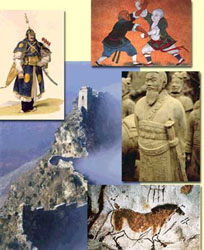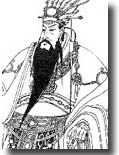
| Home | |||
| About Us | |||
| Overview | |||
| Women | |||
| Culture | |||
| Philosophy | |||
| Practice | |||
| References | |||
| Shaolin | |||
| Hsing Yi | |||
| Tai Chi | |||
| Bagua | |||
| Baji | |||
| Health | |||
| Other Styles | |||
|
|
|||
| Links | |||
| Directory | |||
| News | |||
nderstanding the history of China is an important part of studying kung fu. A rich heritage and tradition are what make this martial art special. The development of kung fu is intimately linked to the evolution of Chinese culture. The following overview provides a glimpse of China's past as well as a context that facilitates our understanding of the history behind individual kung fu styles.
The history of China can best be understood through its geography and its various dynasties.
Geography
The Central Plains (中原) of China and Henan Province, in particular, are often referred to as the cradle of Chinese civilization and also of the Chinese martial arts. The surrounding regions of Henan, Hebei, Shandong and Shanxi provinces also have a rich martial arts heritage. The origin of Shaolin (少林) and Chen Family Taiji (陈式太极) can be traced back to Henan. Baji (八极), Pigua (劈挂) and Mizong (秘宗) can be found in Hebei. Tanglang (Mantis,螳螂) are well known in Shandong. Xinyi quan (心意) are found in Henan, Shanxi and Hebei. Wudang (武当) is developed at Mount Wudang in Hubei province. Bagua (八卦) is strong in Anhui province. is strong in Anhui province. Eventually, all martial arts found themselves competing in the Capital area of Beijing and in the port city of Tienjin.
Other forms of kung fu also developed beyond the Central Plains. In the East, there were the Tibetan forms (White Crane, White Ape). Various martial styles also proliferated in the South, including well-known styles such as Hung-kar (洪家), Choi-lay-fut (蔡李佛), Wing-chun (永春) and Bak-hok (白鹤). Most Southern styles follow in the foot-steps of the original Southern Shaolin school (南少林).
Prehistory
uring this period, life was cruel and merciless. People used crude tools made from stone to defend themselves and to try to control their environment. There were no formal systems of martial arts.
Xuan Yuan (轩辕黄帝), the Yellow Emperor, credited as the Founder of the Chinese Nation, was known for his humanity, intelligence, and wisdom, as well as his martial arts abilities. He is reported to have constantly practiced with spears and halberds against his archenemy, Chi You (蚩尤).
Xia, Shang and Zhou Dynasty (2000 BC - 770 BC)
n this era, there emerged written descriptions of a type of wrestling called jiaoli and other military sports such as archery and chariot racing. Civilization was at its infancy, but various forms of exercise were slowly developing.
Warring States Period (475-221 BC)
he concepts and ideas associated with the martial arts began to permeate society. This was a pivotal period in ancient China, as various factions, representing alternative philosophies, began to compete for the future of China. Each competing fiefdom nurtured its own armies, and the martial arts formed an integral part of society. During this period, Sun Zi, in his "Art of War", commented on the importance of "Wrestling and thrusting exercises to strengthen the warriors' physique." The development of martial prowess was also extended to women. It was during this period, for example, that Yuenu, a distinguished sword mistress, was honoured by Emperor Goujian for her abilities.
The Qin (221-206 BC) and the Han (206 BC - 220 AD)
iterature from this period describes the fighting arts such as shoubo (wrestling), jiaodi (contest of strength involving head butting with cattle horns) and the inclusion of weapons in the performing arts (such as Peking operas). The importance of the martial spirit was captured in the popular novel, San Guo ("The Romance of the Three Kingdoms"), which describes the struggles of Cao Cao and his battle to unify China: Jin (265-439 AD) and the Southern and Northern Dynasties (420 - 581). It is during this period that the martial arts came under the influence of Buddhism and Taoism.
Ge Hong (284-364), a famous physician and Taoist philosopher, is credited with integrating the practice of martial arts to the study of qigong. These theories of "external and internal work" are still applied in kung fu today.
The concept of a distinct Chinese nation began to evolve. China, the Middle Kingdom, developed a unique culture that placed importance on training and the practice of the martial arts.
Da Mo arrived in China in 527 A.D. and stayed at the Shaolin Temple. After nine years, he produced two texts: Yi Jin Jing (Muscle/Tendon Changing Classic) and Xi Sui Jin (Marrow/Brain Washing Classic) to teach the Shaolin monks how to improve their physical stamina and nourish their Chi. He also brought fresh insight into Buddhist theory and created a new school of thought now known as Zen (Chan). As a result, he is acknowledged as both the founder of Shaolin Kungfu and the First Patriarch of Chan Buddhism.
Tang Dynasty (618-907)
uring this period, martial arts became part of the examination process for the imperial courts. All officials and soldiers were required to pass some sort of martial art test before being promoted.
Song Dynasty (960 - 1279)
he martial arts permeated society, as agile performers displayed their skills in the street. Many martial arts societies were formed so that people could protect themselves against lawlessness and the unjust rule of the central government.
The essence of this period was romanticized in Shui hu chuan, ("Water Margin Chronicles" also known as "Outlaws of the Marsh") published 200 years later. This book describes the events that led 108 people (105 men and 3 women) to abandon lawful society and band together as leaders of the outlaw fortress on Mt. Liang in the Liangshan Marsh. Each of those characters had outstanding martial arts training. For example, Wu Song was so skilful that he could fight and defeat a tiger with his bare hands.
Ming Dynasty (1368 -1644)
he Ming dynasty rose up out of a peasant rebellion and ruled over the greatest economic and social revolution in China before the modern period. Once again, martial arts were an important part of society. Qi Jiguang, a well-known general, compiled a book that presents 16 different styles of bare-hand exercises and another 40 of spear- and cudgel-play, each with detailed explanations and illustrations. This book also describes various kung fu theories and training methods.
Qing Dynasty (1644 - 1911)
nderground martial arts societies flourished once again during this period, because of the opposition to the foreign Qing rulers. In response, the Qing rulers limited the practice of martial arts to the elite and nobility. However, martial arts continued to be pervasive, and many of the current kung fu styles can be traced to this era. The end of the Qing Empire and the beginning of the Republic generated renewed interest in the martial arts. Practicing kung fu was seen as being in the national interest because it helped strengthen both the body and the mind.
In 1928, the Nationalist government, under President Chiang Kai-Shek, established the Nanking Central Guoshu Institute in Nanking. Many famous masters and practitioners were recruited for this institute. The traditional name "Wushu" (martial techniques) was changed to "Zhong Guo Wushu" (Chinese martial techniques) or simply "Guoshu" (country techniques). This was the first time in Chinese history that a central government was to combine all the different styles of Chinese martial arts under one teaching institution. Unfortunately, when World War II broke out in 1937, all training was discontinued.
The Present
hinese culture and civilization suffered many setbacks due to colonialism, the two world wars, the Japanese invasion, and a savage civil war. Martial arts practitioners were instrumental in defending the country, but they too were swept up by turmoil of the period.
By the end of the civil war, China was effectively divided in two: Taiwan and the People's Republic of China. Some martial artists escaped to Taiwan or to other foreign countries, but many more stayed behind. More tramatic to Chinese philosophy was the final realization that China was no longer the centre of the Universe.
Over time, the culture and philosophy of the Far East spread to other areas of the world. Initially, practice of the martial arts was limited to the small immigrant populations that left their homeland. The large movement of people that occurred during the Second World War, however, as well as the subsequent conflicts of the Cold War introduced the West to the martial arts tradition. The Japanese sport of Judo and Okinawan martial art of karate were some of the first styles to gain acceptance. During the 1950's, 1960's and 1970's, other styles from the Far East spread to the West: Aikido and Jujitsu from Japan, Tang Soo Do and Tae Kwon Do from Korea. Chinese martial arts did not reach the popular masses until the advent of Bruce Lee. With three movies, Bruce Lee single-handedly generated a huge interest in Chinese kung fu, although he never actually trained extensively in any traditional style except Wing Chung. Still, his athletic ability and charisma attracted the public to this ancient tradition. Over time, this interest led to a deeper appreciation of the variety of Chinese martial arts.
Today, we live in a global village, where everyone has access to information and quality instruction in the rich heritage of the Chinese martial arts. This tradition first developed in China is now part of the cultural fabric of the world.
Copyright 2003


